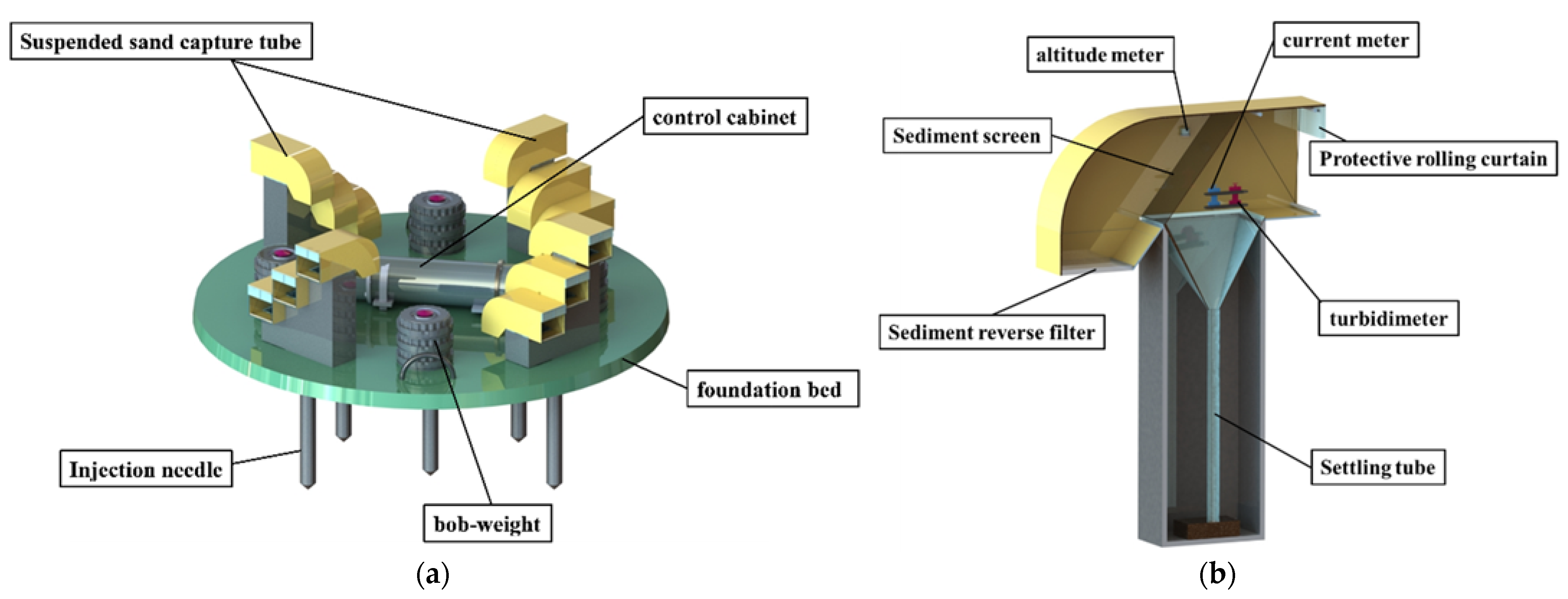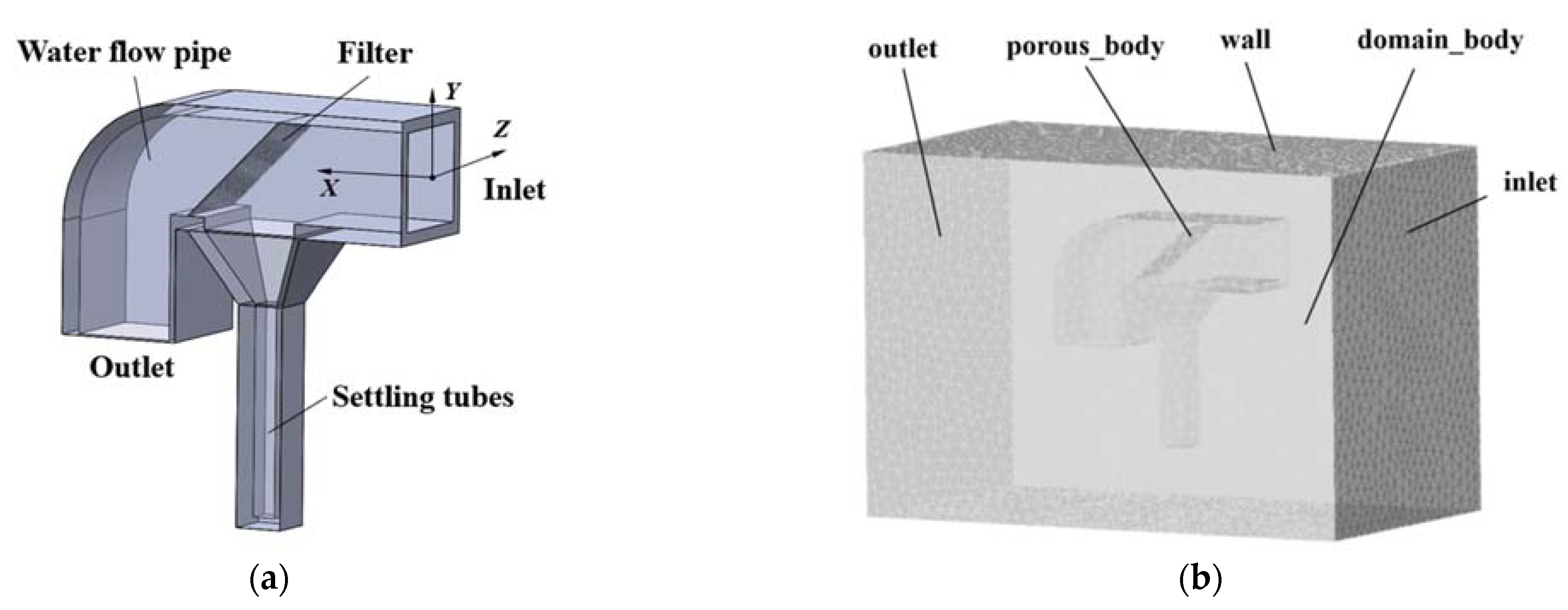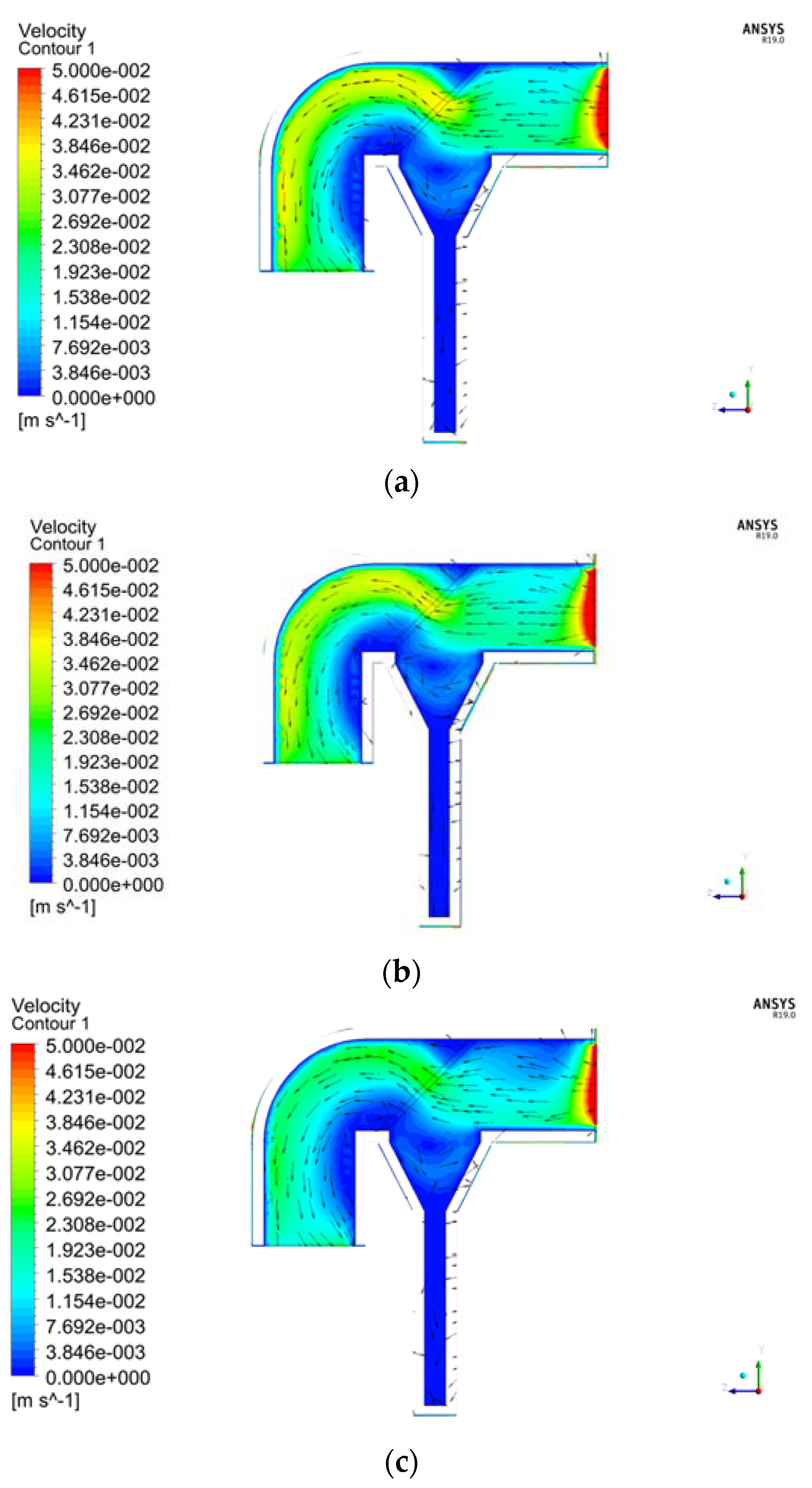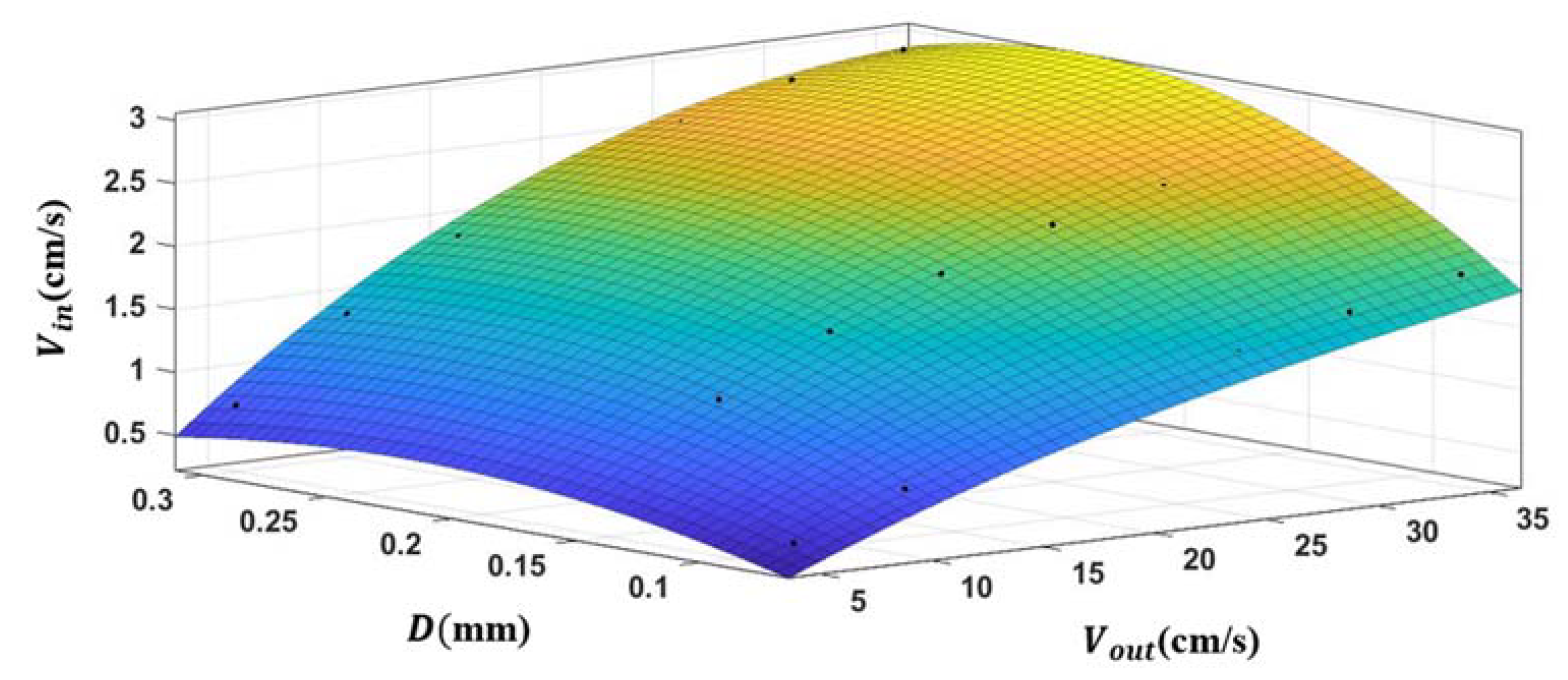The Numerical Investigation of the Performance of a Newly Designed Sediment Trap for Horizontal Transport Flux
Abstract
:1. Introduction
2. Design of 3-D Trap
2.1. Structural Design of 3-D Trap
2.2. Working Principle of the Sediment Trap
2.3. Analytical Equations for Sediment Transport Fluxes
3. Numerical Simulation of the Internal and External Flow Fields of 3-D Trap
3.1. Model Introduction
3.2. Establishment and Meshing of the 3D Model
3.2.1. Establishment of the 3D Model
3.2.2. Meshing
3.3. Setting of Parameters Related to Finite Element Simulation
3.3.1. Idealized Assumptions for Numerical Calculation
3.3.2. Simulation Parameter Setting
3.3.3. Porous Media Model
3.3.4. Fluent Solver Settings
4. Effects of 3-D Trap Structure on Internal and External Flow Fields
4.1. Comparison of the Internal and External Flow Fields of the Capture Tube with Three Screen Pore Sizes
4.2. Correspondence of the Flow Velocity Inside and Outside the Capture Tube
5. Sediment Capture Efficiency of 3-D Trap
5.1. Influence of Changes in Flow Fields on Sediment Particle Motion
5.2. Capture Efficiency of the Trap
6. Conclusions and Prospects
- (1)
- The flow fields inside and outside the capture tube were numerically simulated to investigate the influence of the capture tube structure, screen pore size and other factors on the on-site flow field. Then, we obtained the functional relationship between the velocity inside the capture tube Vin, the pore size D of the filter screen and the ambient flow velocity outside the tube Vout:
- (2)
- The relationship between the internal and external flow fields of the trap with three screen pore sizes was obtained. Moreover, by analyzing the movement state of sediment particles, we acquired the sediment particle sizes and flow velocity ranges that can be captured at different screen pore sizes. The appropriate screen pore size was selected when observing different sediment transport environments.
- (3)
- The simulation, discussion and analysis in this paper focus on the effects of a single capture tube and different pore sizes of the filter screen on the ambient flow field. The influence of the trap on the flow field also involves the size and shape of the capture tube orifice, the shape of the water flow channel, etc. The research methods in this paper can provide a theoretical basis for the later design of the capture tube structure and the observation of sediment transport fluxes.
Author Contributions
Funding
Institutional Review Board Statement
Informed Consent Statement
Data Availability Statement
Acknowledgments
Conflicts of Interest
References
- Milliman, J.D.; Farnsworth, K.L. River Discharge to the Coastal Ocean: A Global Synthesis; Cambridge University Press: Cambridge, UK, 2013; pp. 42–59. [Google Scholar]
- Liu, J.P.; Milliman, J.D.; Gao, S.; Cheng, P. Holocene development of the Yellow River's subaqueous delta, North Yellow Sea. Mar. Geol. 2004, 209, 45–67. [Google Scholar] [CrossRef]
- Guo-Hui, X.U.; Zeng, Y.; Liu, Z.Q.; Zhou, H.G.; Ren, Y.P. The Origin of Storm Sediment Flows in Coast. Period. Ocean Univ. China 2019, 49 (Suppl. S1), 59–65. [Google Scholar]
- Hay, W.W. Detrital sediment fluxes from continents to oceans. Chem. Geol. 1998, 145, 287–323. [Google Scholar] [CrossRef]
- Green, M.O.; Coco, G. Review of wave-driven sediment resuspension and transport in estuaries. Rev. Geophys. 2014, 52, 77–117. [Google Scholar] [CrossRef]
- Qiao, S.; Shi, X.; Zhu, A.; Liu, Y.; Bi, N.; Fang, X.; Gang, Y. Distribution and transport of suspended sediments off the Yellow River (Huanghe) mouth and the nearby Bohai Sea. Estuar. Coast. Shelf Sci. 2010, 86, 337–344. [Google Scholar] [CrossRef]
- Cattaneo, A.; Correggiari, A.; Langone, L.; Trincardi, F. The late-Holocene Gargano subaqueous delta, Adriatic shelf: Sediment pathways and supply fluctuations. Mar. Geol. 2003, 193, 61–91. [Google Scholar] [CrossRef]
- Bradbury, H.J.; Turchyn, A.V. Reevaluating the carbon sink due to sedimentary carbonate formation in modern marine sediments. Earth Planet. Sci. Lett. 2019, 519, 40–49. [Google Scholar] [CrossRef]
- Ouillon, S. Why and How Do We Study Sediment Transport? Focus on Coastal Zones and Ongoing Methods. Water 2018, 10, 390. [Google Scholar] [CrossRef]
- Luo, Z.; Zhu, J.; Wu, H.; Li, X. Dynamics of the Sediment Plume Over the Yangtze Bank in the Yellow and East China Seas. J. Geophys. Res. Oceans. 2017, 122, 10073–10090. [Google Scholar] [CrossRef]
- Xing, F.; Wang, Y.P.; Wang, H.V. Tidal hydrodynamics and fine-grained sediment transport on the radial sand ridge system in the southern Yellow Sea. Mar. Geol. 2012, 291–294, 192–210. [Google Scholar] [CrossRef]
- Dalrymple, R.W.; Zaitlin, B.A.; Boyd, R. Estuarine facies models; conceptual basis and stratigraphic implications. Int. J. Sediment. Res. 1992, 62, 1130–1146. [Google Scholar] [CrossRef]
- Prior, D.B.; Suhayda, J.N.; Lu, N.Z.; Bornhold, B.D.; Keller, G.H.; Wiseman, W.J.; Wright, L.D.; Yang, Z.S. Storm wave reactivation of a submarine landslide. Nature 1989, 341, 47–50. [Google Scholar] [CrossRef]
- Butman, C.A. Sediment trap biases in turbulent flows: Results from a laboratory flume study. J. Mar. Res. 1986, 44, 645–693. [Google Scholar] [CrossRef]
- Barnes, M.P.; O'donoghue, T.; Alsina, J.M.; Baldock, T.E. Direct bed shear stress measurements in bore-driven swash. Coast. Eng. 2009, 56, 853–867. [Google Scholar] [CrossRef]
- Lama, G.F.C.; Sadeghifar, T.; Azad, M.T.; Sihag, P.; Kisi, O. On the Indirect Estimation of Wind Wave Heights over the Southern Coasts of Caspian Sea: A Comparative Analysis. Water 2022, 14, 843. [Google Scholar] [CrossRef]
- Lama, G.F.C.; Rillo Migliorini Giovannini, M.; Errico, A.; Mirzaei, S.; Padulano, R.; Chirico, G.B.; Preti, F. Hydraulic Efficiency of Green-Blue Flood Control Scenarios for Vegetated Rivers: 1D and 2D Unsteady Simulations. Water 2021, 13, 2620. [Google Scholar] [CrossRef]
- Zhan, W.; Wu, J.; Wei, X.; Tang, S.; Zhan, H. Spatio-temporal variation of the suspended sediment concentration in the pearl river estuary observed by modis during 2003–2015. Cont. Shelf Res. 2019, 172, 22–32. [Google Scholar] [CrossRef]
- Peterson, K.; Sagan, V.; Sidike, P.; Cox, A.; Martinez, M. Suspended Sediment Concentration Estimation from Landsat Imagery along the Lower Missouri and Middle Mississippi Rivers Using an Extreme Learning Machine. Remote Sens. 2018, 10, 1503. [Google Scholar] [CrossRef]
- Zhang, C.; Wang, C.; Wang, A.J.; Shi, C. Study of Boundary Effects in the Calibration Process of Ocean Turbidity Sensors. Ocean. Technol. 2012, 31, 44–47. [Google Scholar]
- Thorne, P.D.; Meral, R. Formulations for the scattering properties of suspended sandy sediments for use in the application of acoustics to sediment transport. Cont. Shelf Res. 2008, 28, 309–317. [Google Scholar] [CrossRef]
- Kostaschuk, R.; Best, J.; Villard, P.; Peakall, J.; Franklin, M. Measuring flow velocity and sediment transport with an acoustic Doppler current profiler. Geomorphology 2005, 68, 25–37. [Google Scholar] [CrossRef]
- Zhang, S.; Nielsen, P.; Perrochet, P.; Jia, Y. Multiscale Superposition and Decomposition of Field-Measured Suspended Sediment Concentrations: Implications for Extending 1DV Models to Coastal Oceans With Advected Fine Sediments. J. Geophys. Res. Ocean. 2021, 126, 2020JC016474. [Google Scholar] [CrossRef]
- Zhao, M.X.; Ding, Y.; Meng, Y.U. Sources of Sedimentary Organic Matter in China Marginal Sea Surface Sediments and Implications of Carbon Sink. Period Ocean. Univ. China 2017, 47, 70–76. [Google Scholar]
- Galy, V.; France-Lanord, C.; Beyssac, O.; Faure, P.; Kudrass, H.; Palhol, F. Efficient organic carbon burial in the Bengal fan sustained by the Himalayan erosional system. Nature 2007, 450, 407–410. [Google Scholar] [CrossRef]
- Knauer, G.; Asper, V. Sediment Trap Technology and Sampling; U.S. GOFS Planning Report No. 10; US Global Ocean Flux Study: Woods Hole, MA, USA, 1989. [Google Scholar]
- Volk, T.; Hoffert, M.I. Ocean carbon pumps: Analysis of relative strengths and efficiencies in ocean-driven atmospheric CO2 changes. In The Carbon Cycle and Atmospheric CO2: Natural Variations Archean to Present; American Geophysical Union: Washington, DC, USA, 1985; Volume 32, pp. 99–110. [Google Scholar]
- Iseki, K. Vertical transport of particulate organic matter in the deep Bering Sea and gulf of Alaska. J. Oceanogr. Soc. Jpn. 1981, 37, 101–110. [Google Scholar] [CrossRef]
- Payo, A.; Wallis, H.; Ellis, M.A.; Barkwith, A.; Poate, T. Application of portable streamer traps for obtaining point measurements of total longshore sediment transport rates in mixed sand and gravel beaches. Coast. Eng. 2020, 156, 103580. [Google Scholar] [CrossRef]
- Wang, W.W.; Gong-Bo, M.A.; Cheng, L.; Yuan, L.; Wang, C.J. Development and Application of Cage-Shaped Sediment Trap. Coast. Eng. 2017, 36, 52–58. [Google Scholar]
- Kraus, N.C. Application of Portable Traps for Obtaining Point Measurements of Sediment Transport Rates in the Surf Zone. J. Coast. Res. 1987, 36, 139–152. [Google Scholar]
- Helley, E.J.; Smith, W. Development and Calibration of a Pressure-Difference Bedload Sampler; Open-File Report; US Department of the Interior, Geological Survey, Water Resources Division: Menlo Park, CA, USA, 1971; p. 11.
- Liu, T.; Fei, Z.; Guo, L.; Zhang, J.; Zhang, S.; Zhang, Y. Newly Designed and Experimental Test of the Sediment Trap for Horizontal Transport Flux. Sensors 2022, 22, 4137. [Google Scholar] [CrossRef]
- Byeon, J.H.; Lee, K.H. Numerical Analysis of a Strainer Using Porous Media Technique. In Proceedings of the International Conference on Fluid Mechanics and Flow Analysis, Bangkok, Thailand, 7–8 February 2017. [Google Scholar]
- Nassehi, V.; Hanspal, N.S.; Waghode, A.N.; Ruziwa, W.R.; Wakeman, R.J. Finite-element modelling of combined free/porous flow regimes: Simulation of flow through pleated cartridge filters. Chem. Eng. Sci. 2005, 60, 995–1006. [Google Scholar] [CrossRef]
- Jouybari, N.F.; Maerefat, M.; Nimvari, M.E. A Macroscopic Turbulence Model for Reacting Flow in Porous Media. Transp. Porous Media 2015, 106, 355–381. [Google Scholar] [CrossRef]
- Horton, N.A.; Pokrajac, D. Onset of turbulence in a regular porous medium: An experimental study. Phys. Fluids 2009, 21, 045104. [Google Scholar] [CrossRef]
- Nakayama, A.; Kuwahara, F. A Macroscopic Turbulence Model for Flow in a Porous Medium. J. Fluids Eng. 1999, 121, 427–433. [Google Scholar] [CrossRef]
- Tobisawa, R.Y.I.; de Lemos, M.J.S. Filtration efficiency of particle-laden flows for thermal plug and abandonment of oil wells using turbulence modeling in porous media. Int. Commun. Heat Mass Transf. 2022, 135, 106108. [Google Scholar] [CrossRef]
- Cheng, K.; Zhu, J.; Qian, F.; Cao, B.; Lu, J.; Han, Y. CFD–DEM simulation of particle deposition characteristics of pleated air filter media based on porous media model. Particuology 2023, 72, 37–48. [Google Scholar] [CrossRef]
- Qi, M.; Li, M.; Moghanloo, R.G.; Guo, T. A novel simulation approach for particulate flows during filtration. AIChE J. 2021, 67, e17136. [Google Scholar] [CrossRef]
- Kazemi, E.; Koll, K.; Tait, S.; Shao, S. SPH modelling of turbulent open channel flow over and within natural gravel beds with rough interfacial boundaries. Adv. Water. Resour. 2020, 140, 103557. [Google Scholar] [CrossRef]
- Kazemi, E.; Tait, S.; Shao, S. SPH-based numerical treatment of the interfacial interaction of flow with porous media. Int. J. Numer. Methods Fluids 2020, 92, 219–245. [Google Scholar] [CrossRef]
- Harris, L.; Liang, D.; Shao, S.; Zhang, T.; Roberts, G. MPM simulation of solitary wave run-up on permeable boundaries. Appl. Ocean. Res 2021, 111, 102602. [Google Scholar] [CrossRef]
- ANSYS, Inc. ANSYS FLUENT 14 User’s Guide; ANSYS, Inc.: Canonsburg, PA, USA, 2011; pp. 260–295. Available online: https://vdocuments.net/ansys-fluent-140-theory-guide.html?page=1 (accessed on 6 July 2022).
- Kumari, M.; Nath, G. Unsteady Natural Convection Flow in a Square Cavity Filled with a Porous Medium Due to Impulsive Change in Wall Temperature. Transp. Porous Media 2009, 77, 463–474. [Google Scholar] [CrossRef]
- Izadpanah, M.R. Heat Transfer and Pressure Drop during Single and Two-Phase Flow through Unconsolidated Porous Media; University of Surrey: Guildford, UK, 1999; pp. 79–86. [Google Scholar]
- Sha, Y. Introduction to Sediment Kinematics, 1st ed.; China Industry Press: Beijing, China, 1965; pp. 42–76. [Google Scholar]
- Zhang, R. River Sediment Dynamics, 2nd ed.; China Water Resources and Hydropower Press: Beijing, China, 1998; pp. 48–50. [Google Scholar]
- Jimenez, J.; Madsen, O. A Simple Formula to Estimate Settling Velocity of Natural Sediments. J. Waterw. Port. Coast. Ocean Eng. 2003, 129, 70–78. [Google Scholar] [CrossRef]
- Camenen, B. Simple and General Formula for the Settling Velocity of Particles. J. Hydraul. Eng. 2007, 133, 229–233. [Google Scholar] [CrossRef]










| Mesh Number (Ten Thousand) | 4 | 10 | 20 | 30 | 40 | 50 |
|---|---|---|---|---|---|---|
| Speed of monitoring surface (cm/s) | 0.969 | 0.989 | 1.001 | 1.010 | 1.014 | 1.019 |
| Rate of change (%) | 2.1 | 1.2 | 0.9 | 0.4 | 0.5 |
| Parameters | Values |
|---|---|
| Working medium | Seawater (10 °C) |
| Continuous phase density | 1030 kg/m3 |
| Continuous phase viscosity | 0.001308 kg/(m·s) |
| Parameters | Values | Parameters | Values |
|---|---|---|---|
| Inlet type | Velocity inlet | Outlet type | Pressure outlet |
| Inlet speed | 15–35 cm/s | Outlet pressure | 0 MPa |
| Mesh Number | D/(mm) | Screen Thickness/(m) | Screen Wire Diameter /(mm) | ε% | q/(m2) | C1/(m−2) | C2/(m−1) |
|---|---|---|---|---|---|---|---|
| 50 | 0.300 | 0.001 | 0.112 | 53 | 2.82 × 10−10 | 3.55 × 109 | 36,831.30 |
| 100 | 0.150 | 0.001 | 0.063 | 50 | 7.50 × 10−10 | 1.33 × 1010 | 93,333.33 |
| 200 | 0.075 | 0.001 | 0.045 | 39 | 2.29 × 10−10 | 4.37 × 1010 | 479,891.2 |
Publisher’s Note: MDPI stays neutral with regard to jurisdictional claims in published maps and institutional affiliations. |
© 2022 by the authors. Licensee MDPI, Basel, Switzerland. This article is an open access article distributed under the terms and conditions of the Creative Commons Attribution (CC BY) license (https://creativecommons.org/licenses/by/4.0/).
Share and Cite
Wang, C.; Guo, L.; Zhang, S.; Fei, Z.; Xue, G.; Yang, X.; Zhang, J. The Numerical Investigation of the Performance of a Newly Designed Sediment Trap for Horizontal Transport Flux. Sensors 2022, 22, 7262. https://doi.org/10.3390/s22197262
Wang C, Guo L, Zhang S, Fei Z, Xue G, Yang X, Zhang J. The Numerical Investigation of the Performance of a Newly Designed Sediment Trap for Horizontal Transport Flux. Sensors. 2022; 22(19):7262. https://doi.org/10.3390/s22197262
Chicago/Turabian StyleWang, Cheng, Lei Guo, Shaotong Zhang, Zihang Fei, Gang Xue, Xiuqing Yang, and Jiarui Zhang. 2022. "The Numerical Investigation of the Performance of a Newly Designed Sediment Trap for Horizontal Transport Flux" Sensors 22, no. 19: 7262. https://doi.org/10.3390/s22197262
APA StyleWang, C., Guo, L., Zhang, S., Fei, Z., Xue, G., Yang, X., & Zhang, J. (2022). The Numerical Investigation of the Performance of a Newly Designed Sediment Trap for Horizontal Transport Flux. Sensors, 22(19), 7262. https://doi.org/10.3390/s22197262








